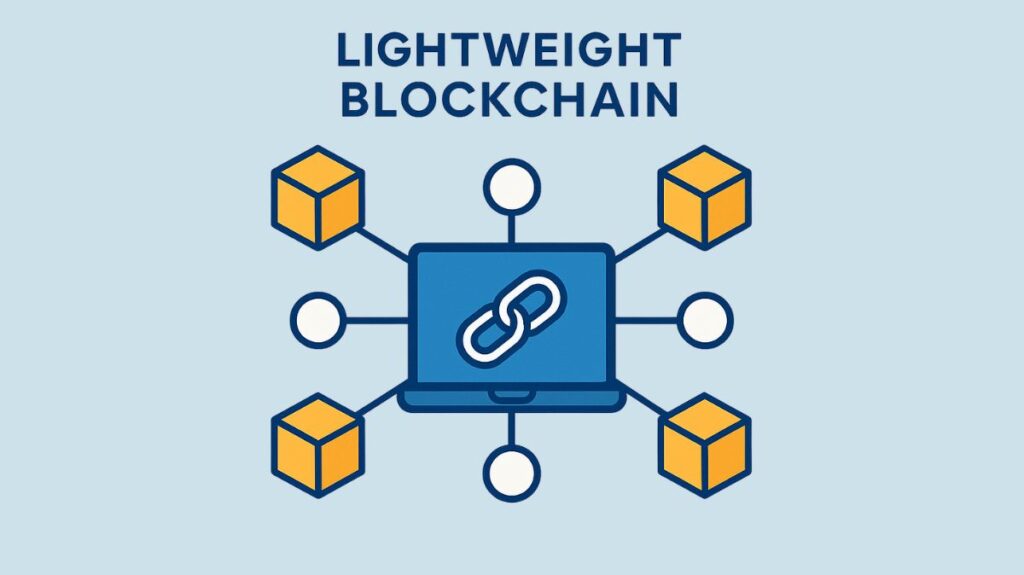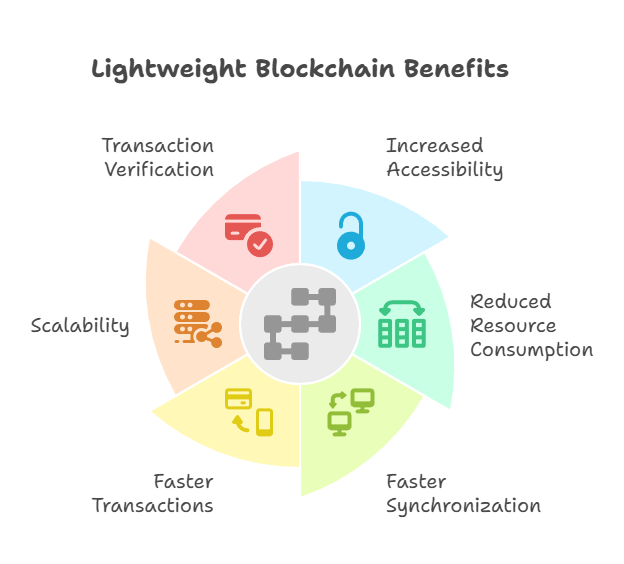Lightweight Blockchain

A lightweight blockchain, also known as a light client or light node, is a kind of blockchain client or node that is made to utilize less bandwidth, storage, and computing power while still being a member of the network. Lightweight nodes don’t keep a full blockchain, unlike full nodes that keep a copy of the blockchain ledger and verify every block and transaction.
Functionality and Storage
- The blockchain is not fully stored or maintained by lightweight nodes. The size of a full copy of a blockchain, such as Bitcoin, which was approximately 350 terabytes at the time of writing, can make it impractical to hold.
- Instead, they accept data blocks containing requisite and essential information, primarily keeping track of block headers. A block header is a small, fixed-size data structure that contains crucial information about a block.
This crucial information includes:
- The hash of the previous block.
- A timestamp.
- The Merkle tree root
- The Merkle tree root is a fundamental cryptographic fingerprint of every block transaction. A light client with the Merkle root can request a transaction and Merkle proof from a full node. The requested transaction is contained in the block and is accurately represented by the Merkle root, according to the Merkle proof, which is a tiny bit of information.
- A lightweight node must make reference to a full node on the network in order to get information from a block it does not possess or to handle its own transactions. By doing this, the light client can confirm that a transaction is legitimate and has been added to the blockchain without having to download the complete block or blockchain history.
- Bitcoin’s Simplified Payment Verification (SPV) serves as the fundamental idea underlying this feature.
You can also read Centralized Communication: Features, Advantages & Examples
Benefits and Advantages

Lightweight Blockchain Benefits
- Increased Accessibility and User Adoption: Lightweight nodes significantly lower the barrier to entry, enabling more people to participate in the blockchain ecosystem without needing expensive hardware or technical expertise. They are particularly suitable for low-resource devices such as mobile phones, embedded devices, tablets, smartphones, laptops, and IoT devices.
- Reduced Resource Consumption: They are highly efficient in terms of storage, CPU usage, and network bandwidth, as they only download a small subset of the blockchain. They consume very little bandwidth.
- Faster Synchronization: A light client can synchronize with the network in seconds or minutes, whereas a full node can take days or even weeks to download the entire blockchain history.
- Faster Transactions: Lightweight nodes facilitate faster transactions because they do not process the complete node data.
- Scalability: Lightweight clients improve the overall scalability of a blockchain network by offloading the heavy computational and storage tasks to full nodes, allowing the network to support more users and transactions.
- They allow devices to verify transactions without needing a complete blockchain and node.
Limitations and Risks
- Reliance on Full Nodes and Trust: Because they do not hold the complete blockchain and do not independently verify every transaction, lightweight nodes must rely on and trust full nodes to provide accurate data. They are considered less flexible and reliable in comparison to full nodes.
- Due to their dependence, they are particularly susceptible to specific types of assaults, like “eclipse attacks,” in which a hacker gains complete control over the nodes that a light client connects to. False information from a malevolent party could result in financial loss or Security Vulnerabilities. Although a light client can reduce this risk by connecting to several complete nodes, it is still more susceptible than a full node.
- Limited Independence: They cannot validate the entire chain independently.
Terminology
- Light clients or incomplete nodes are other names for lightweight nodes.
- The Simplified Payment Verification (SPV) clients used in Bitcoin have a similar concept.
Use Cases and Implementations
- Public blockchains such as Ethereum employ this strategy, allowing light clients to verify transaction execution.
- Mobile cryptocurrency wallets (like the Electrum Bitcoin wallet) and Internet of Things devices that are a part of blockchain networks are two examples.
- Certain DAG-based (Directed Acyclic Graph) networks and other networks or architectures that prioritize light clients and are optimized for minimal resource utilization can also be referred to as “lightweight blockchains.”
To conclude, lightweight blockchain clients are essential for combining blockchain’s decentralized ideals with common devices’ practical limits. Full nodes constitute the network’s backbone, but most people use blockchains daily with light clients, which sacrifice security and stability for accessibility.
You can also read Off Chain Transactions, Purpose, Advantages & Disadvantages
